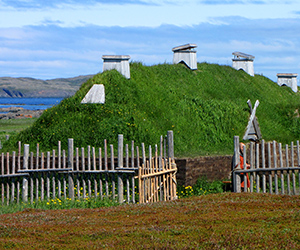CANADA HISTORY
Sarcee

The Sarcee people, also known as the Tsuut'ina, were a Plains Indigenous group who lived in what is now the province of Alberta, Canada. Prior to contact with Europeans, the Sarcee had a nomadic lifestyle and were part of the larger Blackfoot Confederacy. They relied on hunting bison and other wild game for sustenance and clothing, and their nomadic lifestyle allowed them to follow the migration of the bison herds.
The Sarcee were a highly spiritual people, and their beliefs and cultural practices were deeply intertwined with the natural world. They believed in a pantheon of spirits and animals, each with its own specific powers, and they performed ceremonies and rituals to ensure the balance of the natural world and to bring good luck and protection to the community.
Family and community were central to Sarcee life, and the people lived in extended family groups or "tipis." Women played a significant role in Sarcee society and were responsible for many important tasks, such as the creation and maintenance of tipis, the preparation of food, and the care of the children.
The Sarcee were also known for their horsemanship and their participation in intertribal wars and raiding parties. They had a rich oral tradition, including storytelling, song, and dance, which was used to pass down their history, cultural beliefs, and values from generation to generation.
The Sarcee people had their first contact with Europeans in the late 1700s and early 1800s, when European fur traders and explorers began to venture into the region. The Hudson's Bay Company, a British fur trading company, established a trading post in the Sarcee territory in the early 19th century, and this marked the beginning of a more sustained contact between the Sarcee and Europeans.
During this period, the Sarcee and other Indigenous groups in the region engaged in the fur trade with the Europeans, exchanging furs and other goods for goods such as guns, tools, and trade goods. This exchange had a significant impact on the Sarcee way of life, as the introduction of new goods and technologies changed their hunting practices and altered the balance of power between different Indigenous groups.
It was also during this period that the Sarcee and other Indigenous peoples in the region were impacted by diseases introduced by the Europeans, such as smallpox, which caused widespread death and suffering. Nevertheless, despite these challenges, the Sarcee and other Indigenous peoples continued to maintain their cultural practices and traditions, and they continue to do so to this day.
Here are some of the important events and dates in the history of the Sarcee Indigenous people:
Late 1700s to early 1800s: The Sarcee people have their first contact with Europeans, primarily through the fur trade.
1821: The Hudson's Bay Company establishes a trading post in Sarcee territory.
1877: The Sarcee people sign Treaty 7 with the Canadian government, which established a reserve for the Sarcee people in present-day Alberta.
1885: The North-West Rebellion takes place, during which some Sarcee people fought alongside other Indigenous groups against the Canadian government.
1910: The Sarcee people lose control of their reserve, as the Canadian government assumes control of their land and resources.
1970s to 1980s: The Sarcee people begin to assert their rights and reclaim control over their land and resources.
1991: The Sarcee people win a landmark Supreme Court of Canada case, which recognizes their treaty rights and the ongoing existence of their Nation.
1997: The Sarcee people sign a land claim agreement with the Canadian government, which provides for the transfer of approximately 5,000 hectares of land back to the Sarcee people.
Some of the importnat people in the history and heritage of the Sarcee people were:
Running Rabbit: A Sarcee chief who signed Treaty 7 on behalf of his people in 1877.
Little Plume: A Sarcee warrior who fought in the North-West Rebellion of 1885.
Chief Jacob Gladstone: A Sarcee chief who played a significant role in the negotiations leading to the 1997 Sarcee land claim agreement.
Wilton Goodstriker: A Sarcee elder who played a significant role in the reclamation of Sarcee treaty rights and the assertion of Sarcee sovereignty in the late 20th century.
Cite Article : www.canadahistory.com/sections/documents




